Critical Analysis of Employee Privacy in the Workplace
VerifiedAdded on 2022/11/19
|10
|2518
|304
Report
AI Summary
This report provides a critical analysis of privacy in the workplace, examining the rights of employees and the ways in which these rights can be violated. It explores the concept of privacy, the use of surveillance technology, and the importance of maintaining a balance between employer needs and employee privacy. The report delves into the legal and ethical considerations of workplace privacy, including examples of invasion of privacy and the impact on employee morale and productivity. It also analyzes the Privacy Regulation Theory to understand how individuals manage their privacy in the workplace and offers recommendations for management to protect employee privacy. The report also identifies literature gaps and provides a comprehensive overview of the key issues surrounding employee privacy and the need for a secure and respectful work environment.
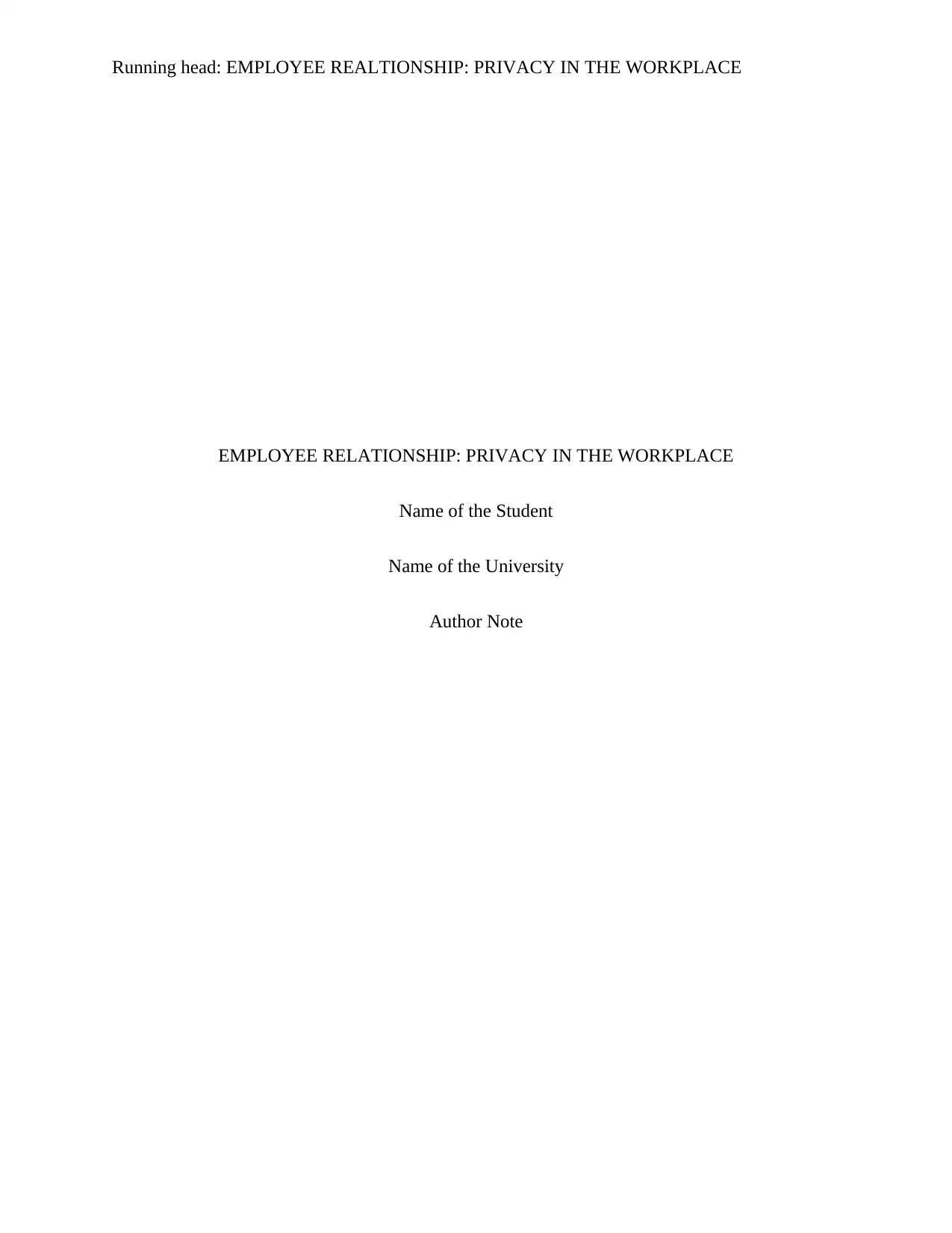
Running head: EMPLOYEE REALTIONSHIP: PRIVACY IN THE WORKPLACE
EMPLOYEE RELATIONSHIP: PRIVACY IN THE WORKPLACE
Name of the Student
Name of the University
Author Note
EMPLOYEE RELATIONSHIP: PRIVACY IN THE WORKPLACE
Name of the Student
Name of the University
Author Note
Paraphrase This Document
Need a fresh take? Get an instant paraphrase of this document with our AI Paraphraser
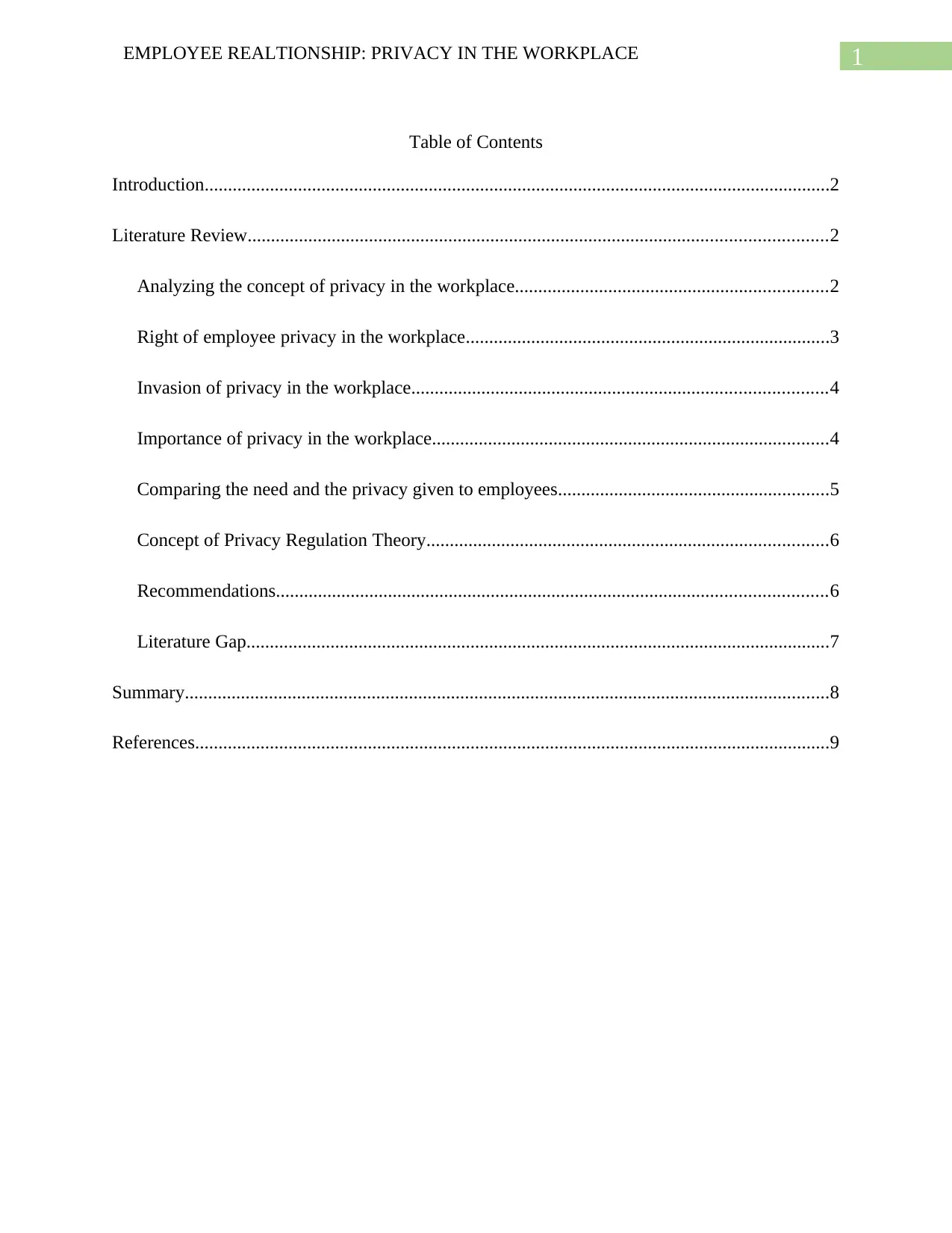
1EMPLOYEE REALTIONSHIP: PRIVACY IN THE WORKPLACE
Table of Contents
Introduction......................................................................................................................................2
Literature Review............................................................................................................................2
Analyzing the concept of privacy in the workplace...................................................................2
Right of employee privacy in the workplace..............................................................................3
Invasion of privacy in the workplace.........................................................................................4
Importance of privacy in the workplace.....................................................................................4
Comparing the need and the privacy given to employees..........................................................5
Concept of Privacy Regulation Theory......................................................................................6
Recommendations......................................................................................................................6
Literature Gap.............................................................................................................................7
Summary..........................................................................................................................................8
References........................................................................................................................................9
Table of Contents
Introduction......................................................................................................................................2
Literature Review............................................................................................................................2
Analyzing the concept of privacy in the workplace...................................................................2
Right of employee privacy in the workplace..............................................................................3
Invasion of privacy in the workplace.........................................................................................4
Importance of privacy in the workplace.....................................................................................4
Comparing the need and the privacy given to employees..........................................................5
Concept of Privacy Regulation Theory......................................................................................6
Recommendations......................................................................................................................6
Literature Gap.............................................................................................................................7
Summary..........................................................................................................................................8
References........................................................................................................................................9
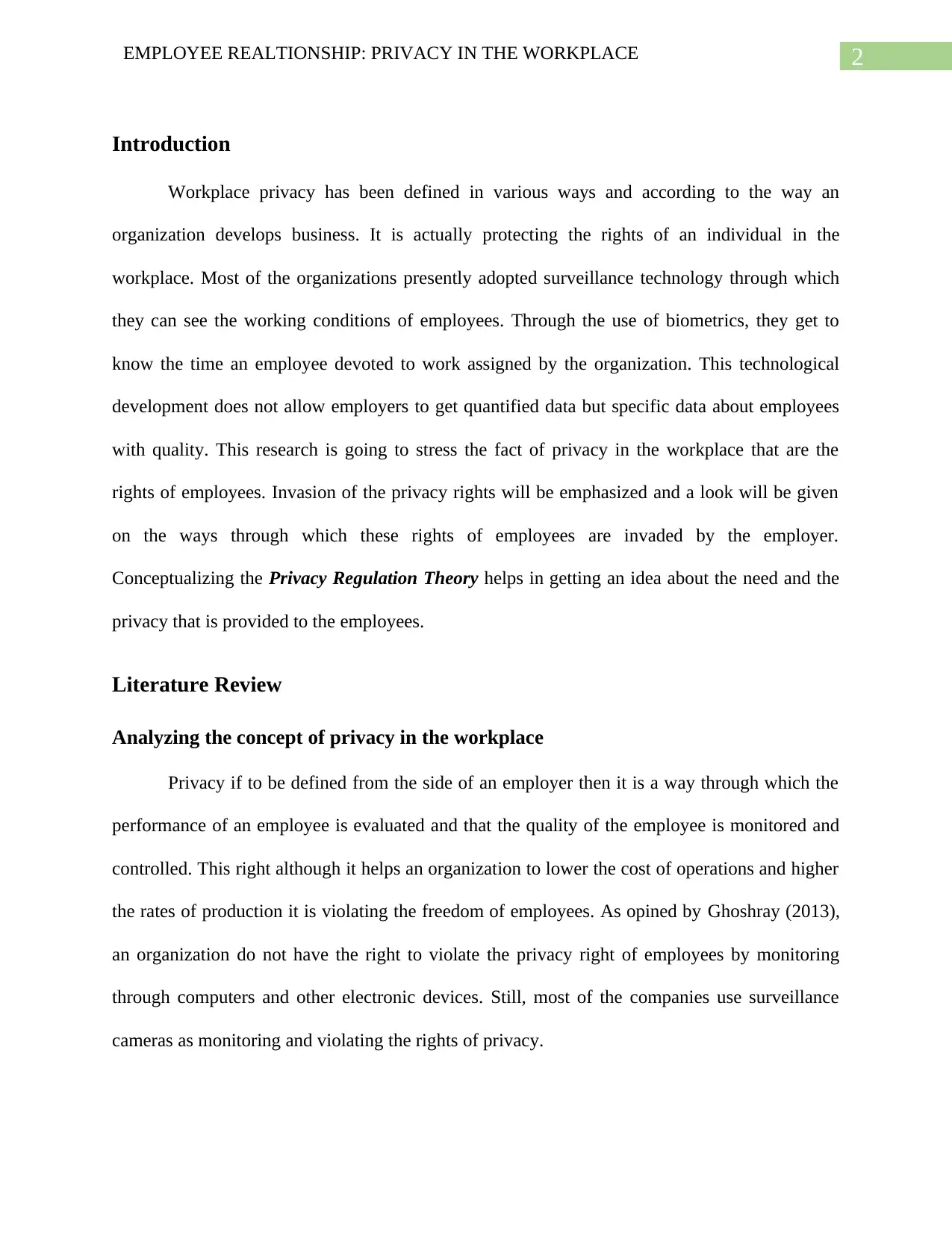
2EMPLOYEE REALTIONSHIP: PRIVACY IN THE WORKPLACE
Introduction
Workplace privacy has been defined in various ways and according to the way an
organization develops business. It is actually protecting the rights of an individual in the
workplace. Most of the organizations presently adopted surveillance technology through which
they can see the working conditions of employees. Through the use of biometrics, they get to
know the time an employee devoted to work assigned by the organization. This technological
development does not allow employers to get quantified data but specific data about employees
with quality. This research is going to stress the fact of privacy in the workplace that are the
rights of employees. Invasion of the privacy rights will be emphasized and a look will be given
on the ways through which these rights of employees are invaded by the employer.
Conceptualizing the Privacy Regulation Theory helps in getting an idea about the need and the
privacy that is provided to the employees.
Literature Review
Analyzing the concept of privacy in the workplace
Privacy if to be defined from the side of an employer then it is a way through which the
performance of an employee is evaluated and that the quality of the employee is monitored and
controlled. This right although it helps an organization to lower the cost of operations and higher
the rates of production it is violating the freedom of employees. As opined by Ghoshray (2013),
an organization do not have the right to violate the privacy right of employees by monitoring
through computers and other electronic devices. Still, most of the companies use surveillance
cameras as monitoring and violating the rights of privacy.
Introduction
Workplace privacy has been defined in various ways and according to the way an
organization develops business. It is actually protecting the rights of an individual in the
workplace. Most of the organizations presently adopted surveillance technology through which
they can see the working conditions of employees. Through the use of biometrics, they get to
know the time an employee devoted to work assigned by the organization. This technological
development does not allow employers to get quantified data but specific data about employees
with quality. This research is going to stress the fact of privacy in the workplace that are the
rights of employees. Invasion of the privacy rights will be emphasized and a look will be given
on the ways through which these rights of employees are invaded by the employer.
Conceptualizing the Privacy Regulation Theory helps in getting an idea about the need and the
privacy that is provided to the employees.
Literature Review
Analyzing the concept of privacy in the workplace
Privacy if to be defined from the side of an employer then it is a way through which the
performance of an employee is evaluated and that the quality of the employee is monitored and
controlled. This right although it helps an organization to lower the cost of operations and higher
the rates of production it is violating the freedom of employees. As opined by Ghoshray (2013),
an organization do not have the right to violate the privacy right of employees by monitoring
through computers and other electronic devices. Still, most of the companies use surveillance
cameras as monitoring and violating the rights of privacy.
⊘ This is a preview!⊘
Do you want full access?
Subscribe today to unlock all pages.

Trusted by 1+ million students worldwide
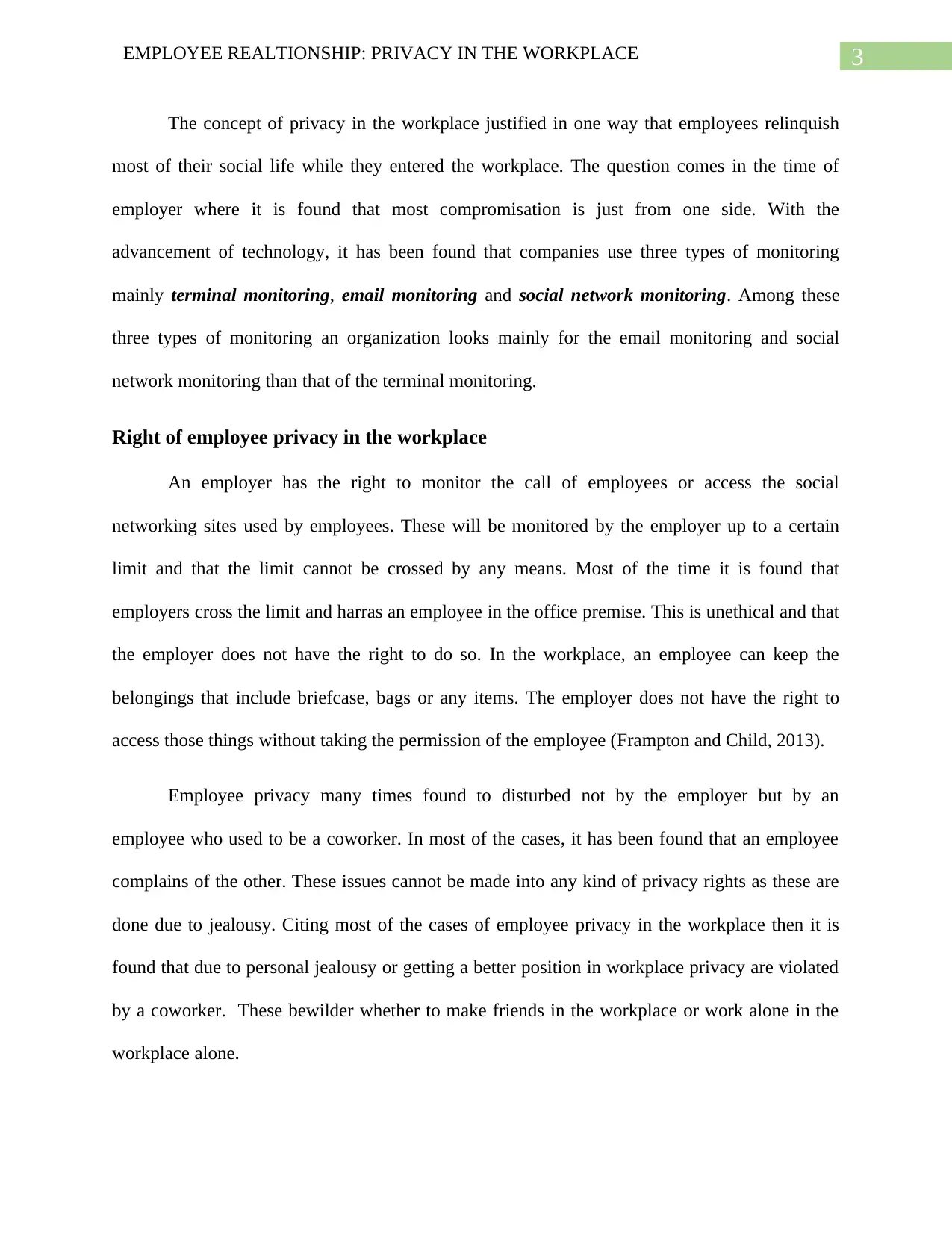
3EMPLOYEE REALTIONSHIP: PRIVACY IN THE WORKPLACE
The concept of privacy in the workplace justified in one way that employees relinquish
most of their social life while they entered the workplace. The question comes in the time of
employer where it is found that most compromisation is just from one side. With the
advancement of technology, it has been found that companies use three types of monitoring
mainly terminal monitoring, email monitoring and social network monitoring. Among these
three types of monitoring an organization looks mainly for the email monitoring and social
network monitoring than that of the terminal monitoring.
Right of employee privacy in the workplace
An employer has the right to monitor the call of employees or access the social
networking sites used by employees. These will be monitored by the employer up to a certain
limit and that the limit cannot be crossed by any means. Most of the time it is found that
employers cross the limit and harras an employee in the office premise. This is unethical and that
the employer does not have the right to do so. In the workplace, an employee can keep the
belongings that include briefcase, bags or any items. The employer does not have the right to
access those things without taking the permission of the employee (Frampton and Child, 2013).
Employee privacy many times found to disturbed not by the employer but by an
employee who used to be a coworker. In most of the cases, it has been found that an employee
complains of the other. These issues cannot be made into any kind of privacy rights as these are
done due to jealousy. Citing most of the cases of employee privacy in the workplace then it is
found that due to personal jealousy or getting a better position in workplace privacy are violated
by a coworker. These bewilder whether to make friends in the workplace or work alone in the
workplace alone.
The concept of privacy in the workplace justified in one way that employees relinquish
most of their social life while they entered the workplace. The question comes in the time of
employer where it is found that most compromisation is just from one side. With the
advancement of technology, it has been found that companies use three types of monitoring
mainly terminal monitoring, email monitoring and social network monitoring. Among these
three types of monitoring an organization looks mainly for the email monitoring and social
network monitoring than that of the terminal monitoring.
Right of employee privacy in the workplace
An employer has the right to monitor the call of employees or access the social
networking sites used by employees. These will be monitored by the employer up to a certain
limit and that the limit cannot be crossed by any means. Most of the time it is found that
employers cross the limit and harras an employee in the office premise. This is unethical and that
the employer does not have the right to do so. In the workplace, an employee can keep the
belongings that include briefcase, bags or any items. The employer does not have the right to
access those things without taking the permission of the employee (Frampton and Child, 2013).
Employee privacy many times found to disturbed not by the employer but by an
employee who used to be a coworker. In most of the cases, it has been found that an employee
complains of the other. These issues cannot be made into any kind of privacy rights as these are
done due to jealousy. Citing most of the cases of employee privacy in the workplace then it is
found that due to personal jealousy or getting a better position in workplace privacy are violated
by a coworker. These bewilder whether to make friends in the workplace or work alone in the
workplace alone.
Paraphrase This Document
Need a fresh take? Get an instant paraphrase of this document with our AI Paraphraser
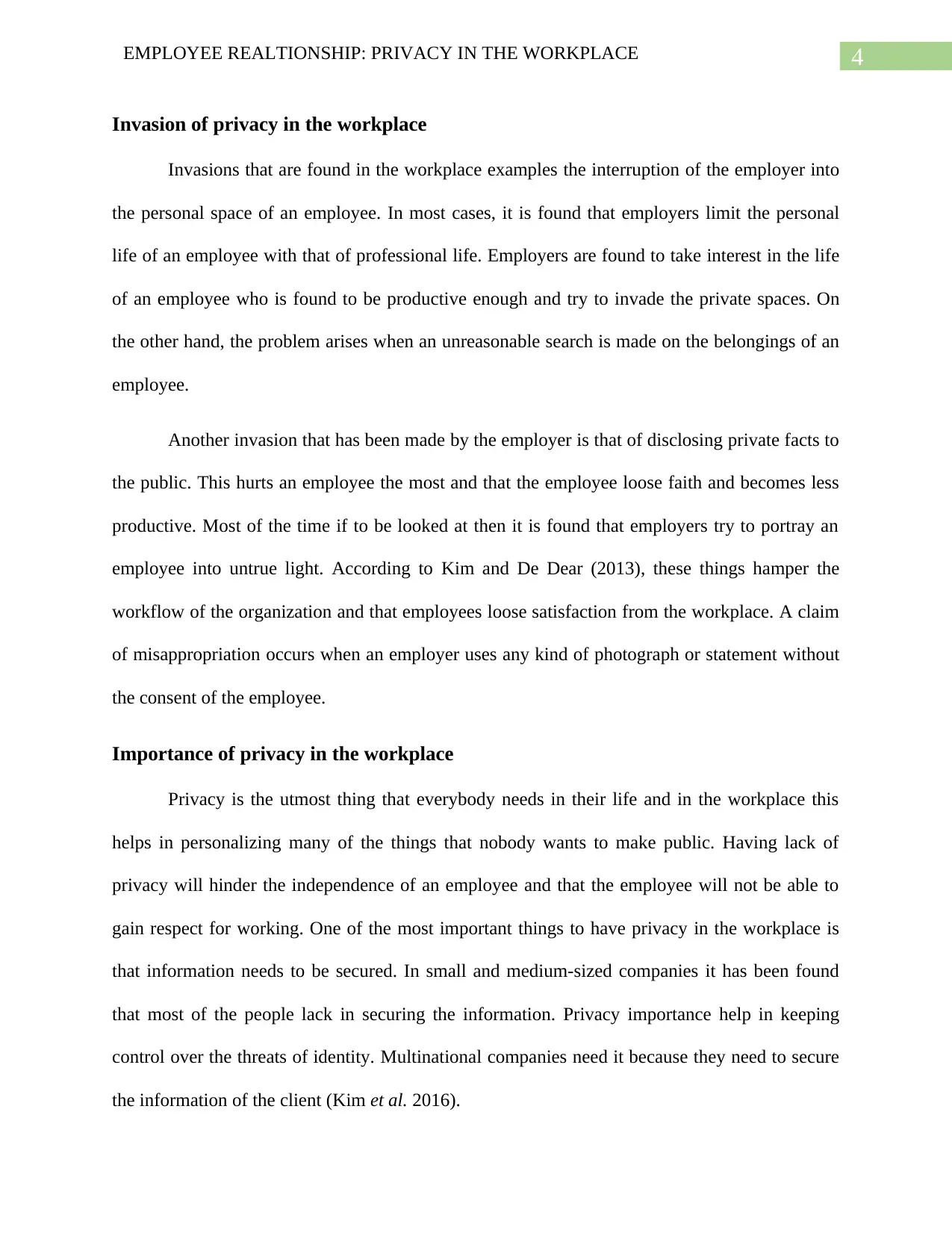
4EMPLOYEE REALTIONSHIP: PRIVACY IN THE WORKPLACE
Invasion of privacy in the workplace
Invasions that are found in the workplace examples the interruption of the employer into
the personal space of an employee. In most cases, it is found that employers limit the personal
life of an employee with that of professional life. Employers are found to take interest in the life
of an employee who is found to be productive enough and try to invade the private spaces. On
the other hand, the problem arises when an unreasonable search is made on the belongings of an
employee.
Another invasion that has been made by the employer is that of disclosing private facts to
the public. This hurts an employee the most and that the employee loose faith and becomes less
productive. Most of the time if to be looked at then it is found that employers try to portray an
employee into untrue light. According to Kim and De Dear (2013), these things hamper the
workflow of the organization and that employees loose satisfaction from the workplace. A claim
of misappropriation occurs when an employer uses any kind of photograph or statement without
the consent of the employee.
Importance of privacy in the workplace
Privacy is the utmost thing that everybody needs in their life and in the workplace this
helps in personalizing many of the things that nobody wants to make public. Having lack of
privacy will hinder the independence of an employee and that the employee will not be able to
gain respect for working. One of the most important things to have privacy in the workplace is
that information needs to be secured. In small and medium-sized companies it has been found
that most of the people lack in securing the information. Privacy importance help in keeping
control over the threats of identity. Multinational companies need it because they need to secure
the information of the client (Kim et al. 2016).
Invasion of privacy in the workplace
Invasions that are found in the workplace examples the interruption of the employer into
the personal space of an employee. In most cases, it is found that employers limit the personal
life of an employee with that of professional life. Employers are found to take interest in the life
of an employee who is found to be productive enough and try to invade the private spaces. On
the other hand, the problem arises when an unreasonable search is made on the belongings of an
employee.
Another invasion that has been made by the employer is that of disclosing private facts to
the public. This hurts an employee the most and that the employee loose faith and becomes less
productive. Most of the time if to be looked at then it is found that employers try to portray an
employee into untrue light. According to Kim and De Dear (2013), these things hamper the
workflow of the organization and that employees loose satisfaction from the workplace. A claim
of misappropriation occurs when an employer uses any kind of photograph or statement without
the consent of the employee.
Importance of privacy in the workplace
Privacy is the utmost thing that everybody needs in their life and in the workplace this
helps in personalizing many of the things that nobody wants to make public. Having lack of
privacy will hinder the independence of an employee and that the employee will not be able to
gain respect for working. One of the most important things to have privacy in the workplace is
that information needs to be secured. In small and medium-sized companies it has been found
that most of the people lack in securing the information. Privacy importance help in keeping
control over the threats of identity. Multinational companies need it because they need to secure
the information of the client (Kim et al. 2016).
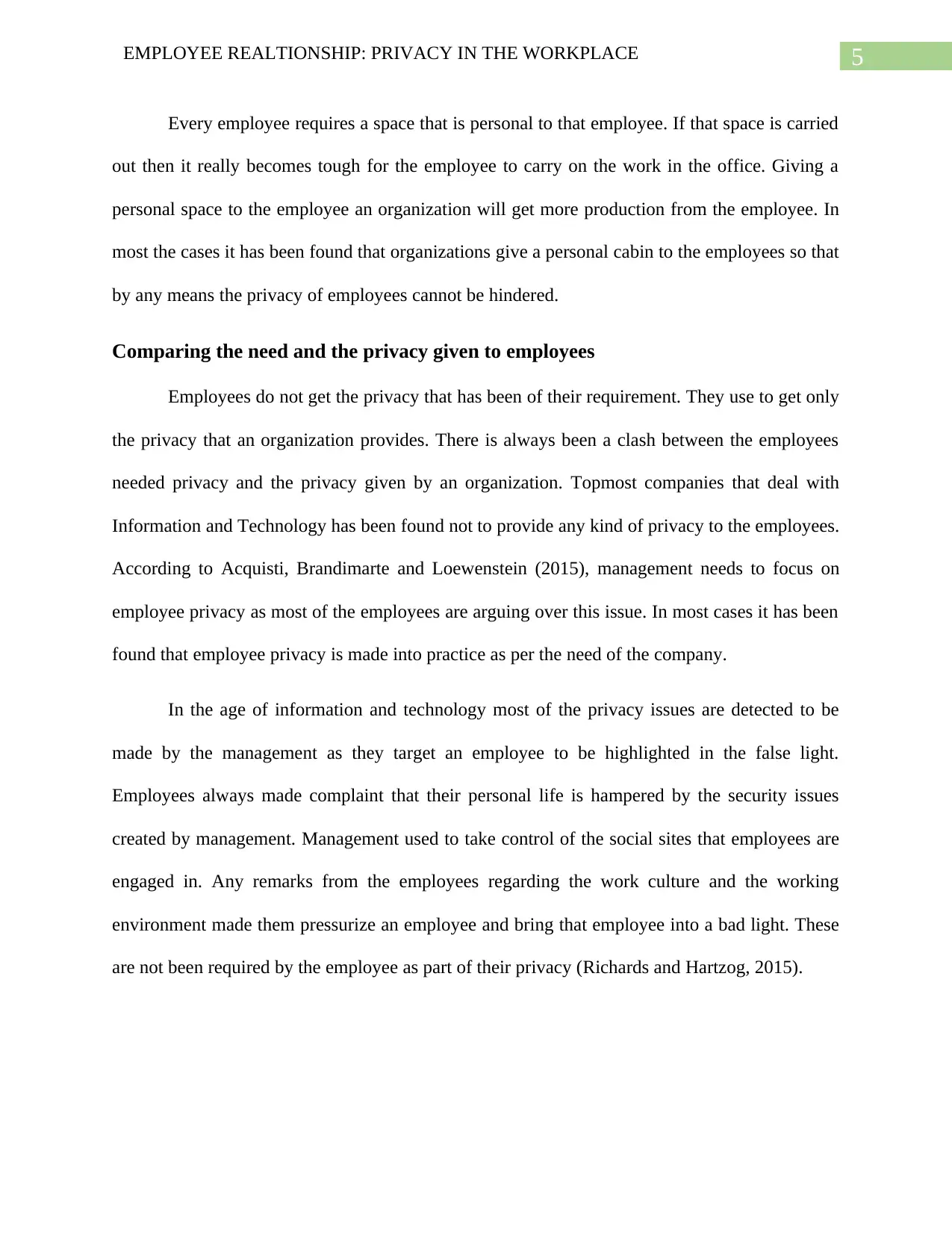
5EMPLOYEE REALTIONSHIP: PRIVACY IN THE WORKPLACE
Every employee requires a space that is personal to that employee. If that space is carried
out then it really becomes tough for the employee to carry on the work in the office. Giving a
personal space to the employee an organization will get more production from the employee. In
most the cases it has been found that organizations give a personal cabin to the employees so that
by any means the privacy of employees cannot be hindered.
Comparing the need and the privacy given to employees
Employees do not get the privacy that has been of their requirement. They use to get only
the privacy that an organization provides. There is always been a clash between the employees
needed privacy and the privacy given by an organization. Topmost companies that deal with
Information and Technology has been found not to provide any kind of privacy to the employees.
According to Acquisti, Brandimarte and Loewenstein (2015), management needs to focus on
employee privacy as most of the employees are arguing over this issue. In most cases it has been
found that employee privacy is made into practice as per the need of the company.
In the age of information and technology most of the privacy issues are detected to be
made by the management as they target an employee to be highlighted in the false light.
Employees always made complaint that their personal life is hampered by the security issues
created by management. Management used to take control of the social sites that employees are
engaged in. Any remarks from the employees regarding the work culture and the working
environment made them pressurize an employee and bring that employee into a bad light. These
are not been required by the employee as part of their privacy (Richards and Hartzog, 2015).
Every employee requires a space that is personal to that employee. If that space is carried
out then it really becomes tough for the employee to carry on the work in the office. Giving a
personal space to the employee an organization will get more production from the employee. In
most the cases it has been found that organizations give a personal cabin to the employees so that
by any means the privacy of employees cannot be hindered.
Comparing the need and the privacy given to employees
Employees do not get the privacy that has been of their requirement. They use to get only
the privacy that an organization provides. There is always been a clash between the employees
needed privacy and the privacy given by an organization. Topmost companies that deal with
Information and Technology has been found not to provide any kind of privacy to the employees.
According to Acquisti, Brandimarte and Loewenstein (2015), management needs to focus on
employee privacy as most of the employees are arguing over this issue. In most cases it has been
found that employee privacy is made into practice as per the need of the company.
In the age of information and technology most of the privacy issues are detected to be
made by the management as they target an employee to be highlighted in the false light.
Employees always made complaint that their personal life is hampered by the security issues
created by management. Management used to take control of the social sites that employees are
engaged in. Any remarks from the employees regarding the work culture and the working
environment made them pressurize an employee and bring that employee into a bad light. These
are not been required by the employee as part of their privacy (Richards and Hartzog, 2015).
⊘ This is a preview!⊘
Do you want full access?
Subscribe today to unlock all pages.

Trusted by 1+ million students worldwide
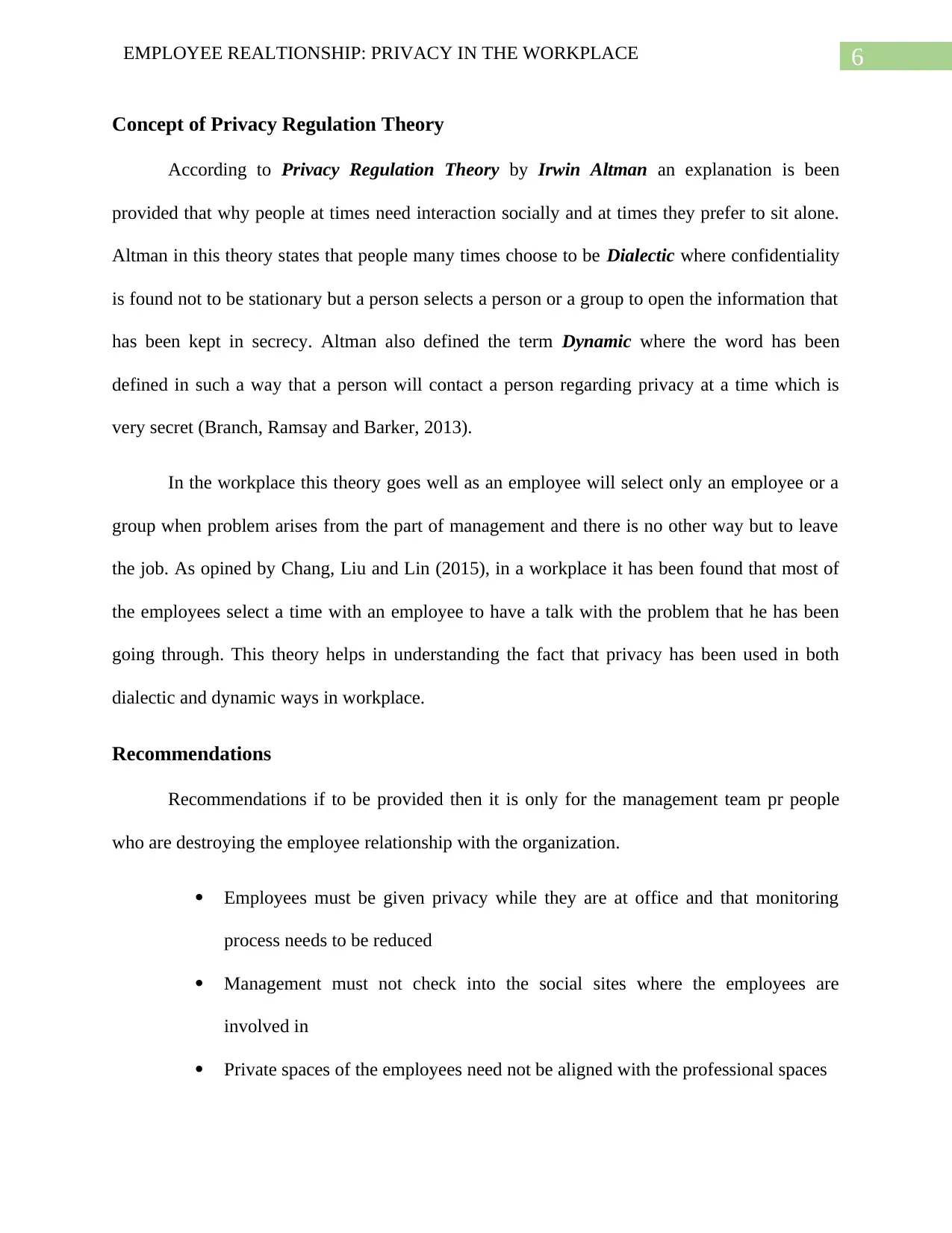
6EMPLOYEE REALTIONSHIP: PRIVACY IN THE WORKPLACE
Concept of Privacy Regulation Theory
According to Privacy Regulation Theory by Irwin Altman an explanation is been
provided that why people at times need interaction socially and at times they prefer to sit alone.
Altman in this theory states that people many times choose to be Dialectic where confidentiality
is found not to be stationary but a person selects a person or a group to open the information that
has been kept in secrecy. Altman also defined the term Dynamic where the word has been
defined in such a way that a person will contact a person regarding privacy at a time which is
very secret (Branch, Ramsay and Barker, 2013).
In the workplace this theory goes well as an employee will select only an employee or a
group when problem arises from the part of management and there is no other way but to leave
the job. As opined by Chang, Liu and Lin (2015), in a workplace it has been found that most of
the employees select a time with an employee to have a talk with the problem that he has been
going through. This theory helps in understanding the fact that privacy has been used in both
dialectic and dynamic ways in workplace.
Recommendations
Recommendations if to be provided then it is only for the management team pr people
who are destroying the employee relationship with the organization.
Employees must be given privacy while they are at office and that monitoring
process needs to be reduced
Management must not check into the social sites where the employees are
involved in
Private spaces of the employees need not be aligned with the professional spaces
Concept of Privacy Regulation Theory
According to Privacy Regulation Theory by Irwin Altman an explanation is been
provided that why people at times need interaction socially and at times they prefer to sit alone.
Altman in this theory states that people many times choose to be Dialectic where confidentiality
is found not to be stationary but a person selects a person or a group to open the information that
has been kept in secrecy. Altman also defined the term Dynamic where the word has been
defined in such a way that a person will contact a person regarding privacy at a time which is
very secret (Branch, Ramsay and Barker, 2013).
In the workplace this theory goes well as an employee will select only an employee or a
group when problem arises from the part of management and there is no other way but to leave
the job. As opined by Chang, Liu and Lin (2015), in a workplace it has been found that most of
the employees select a time with an employee to have a talk with the problem that he has been
going through. This theory helps in understanding the fact that privacy has been used in both
dialectic and dynamic ways in workplace.
Recommendations
Recommendations if to be provided then it is only for the management team pr people
who are destroying the employee relationship with the organization.
Employees must be given privacy while they are at office and that monitoring
process needs to be reduced
Management must not check into the social sites where the employees are
involved in
Private spaces of the employees need not be aligned with the professional spaces
Paraphrase This Document
Need a fresh take? Get an instant paraphrase of this document with our AI Paraphraser
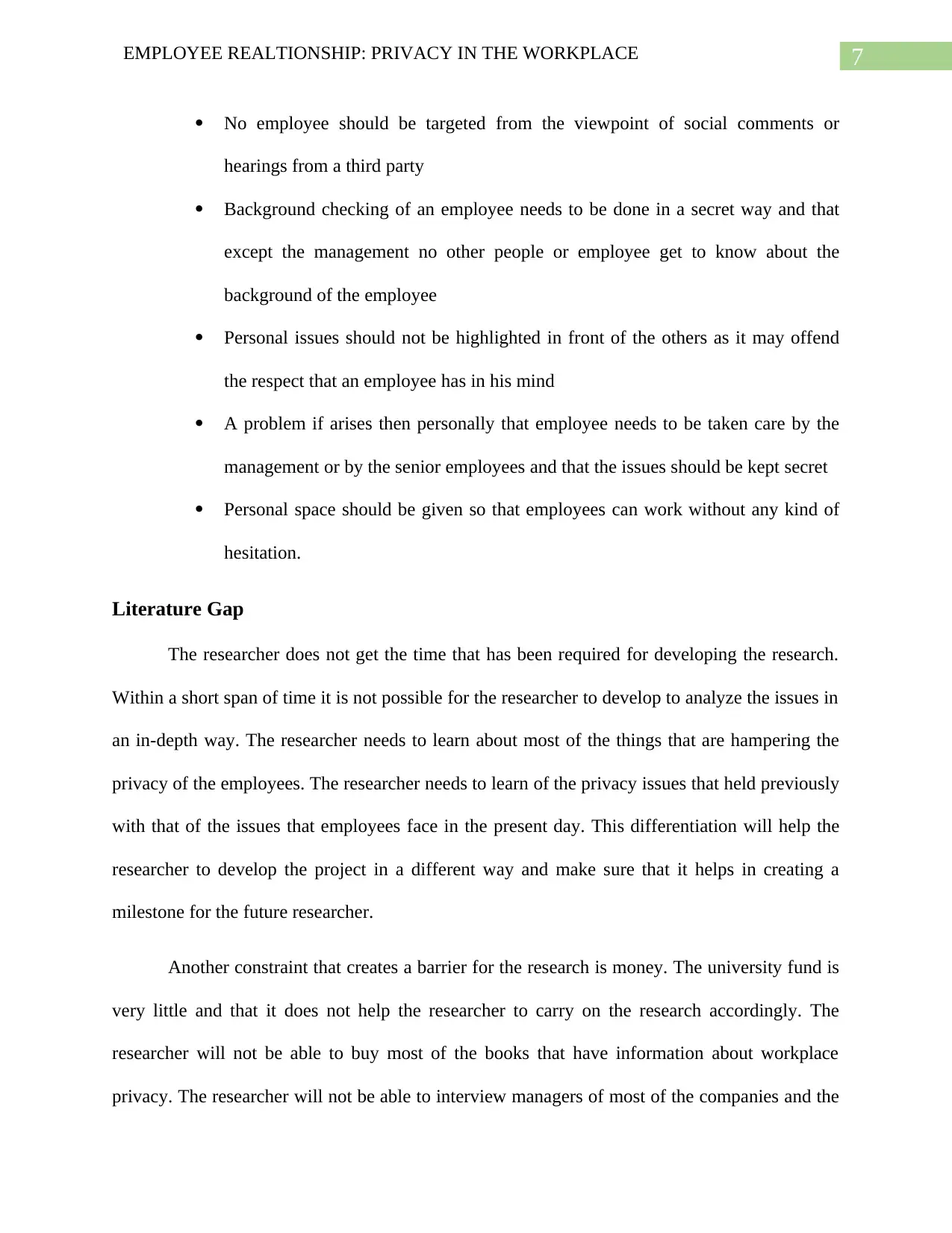
7EMPLOYEE REALTIONSHIP: PRIVACY IN THE WORKPLACE
No employee should be targeted from the viewpoint of social comments or
hearings from a third party
Background checking of an employee needs to be done in a secret way and that
except the management no other people or employee get to know about the
background of the employee
Personal issues should not be highlighted in front of the others as it may offend
the respect that an employee has in his mind
A problem if arises then personally that employee needs to be taken care by the
management or by the senior employees and that the issues should be kept secret
Personal space should be given so that employees can work without any kind of
hesitation.
Literature Gap
The researcher does not get the time that has been required for developing the research.
Within a short span of time it is not possible for the researcher to develop to analyze the issues in
an in-depth way. The researcher needs to learn about most of the things that are hampering the
privacy of the employees. The researcher needs to learn of the privacy issues that held previously
with that of the issues that employees face in the present day. This differentiation will help the
researcher to develop the project in a different way and make sure that it helps in creating a
milestone for the future researcher.
Another constraint that creates a barrier for the research is money. The university fund is
very little and that it does not help the researcher to carry on the research accordingly. The
researcher will not be able to buy most of the books that have information about workplace
privacy. The researcher will not be able to interview managers of most of the companies and the
No employee should be targeted from the viewpoint of social comments or
hearings from a third party
Background checking of an employee needs to be done in a secret way and that
except the management no other people or employee get to know about the
background of the employee
Personal issues should not be highlighted in front of the others as it may offend
the respect that an employee has in his mind
A problem if arises then personally that employee needs to be taken care by the
management or by the senior employees and that the issues should be kept secret
Personal space should be given so that employees can work without any kind of
hesitation.
Literature Gap
The researcher does not get the time that has been required for developing the research.
Within a short span of time it is not possible for the researcher to develop to analyze the issues in
an in-depth way. The researcher needs to learn about most of the things that are hampering the
privacy of the employees. The researcher needs to learn of the privacy issues that held previously
with that of the issues that employees face in the present day. This differentiation will help the
researcher to develop the project in a different way and make sure that it helps in creating a
milestone for the future researcher.
Another constraint that creates a barrier for the research is money. The university fund is
very little and that it does not help the researcher to carry on the research accordingly. The
researcher will not be able to buy most of the books that have information about workplace
privacy. The researcher will not be able to interview managers of most of the companies and the
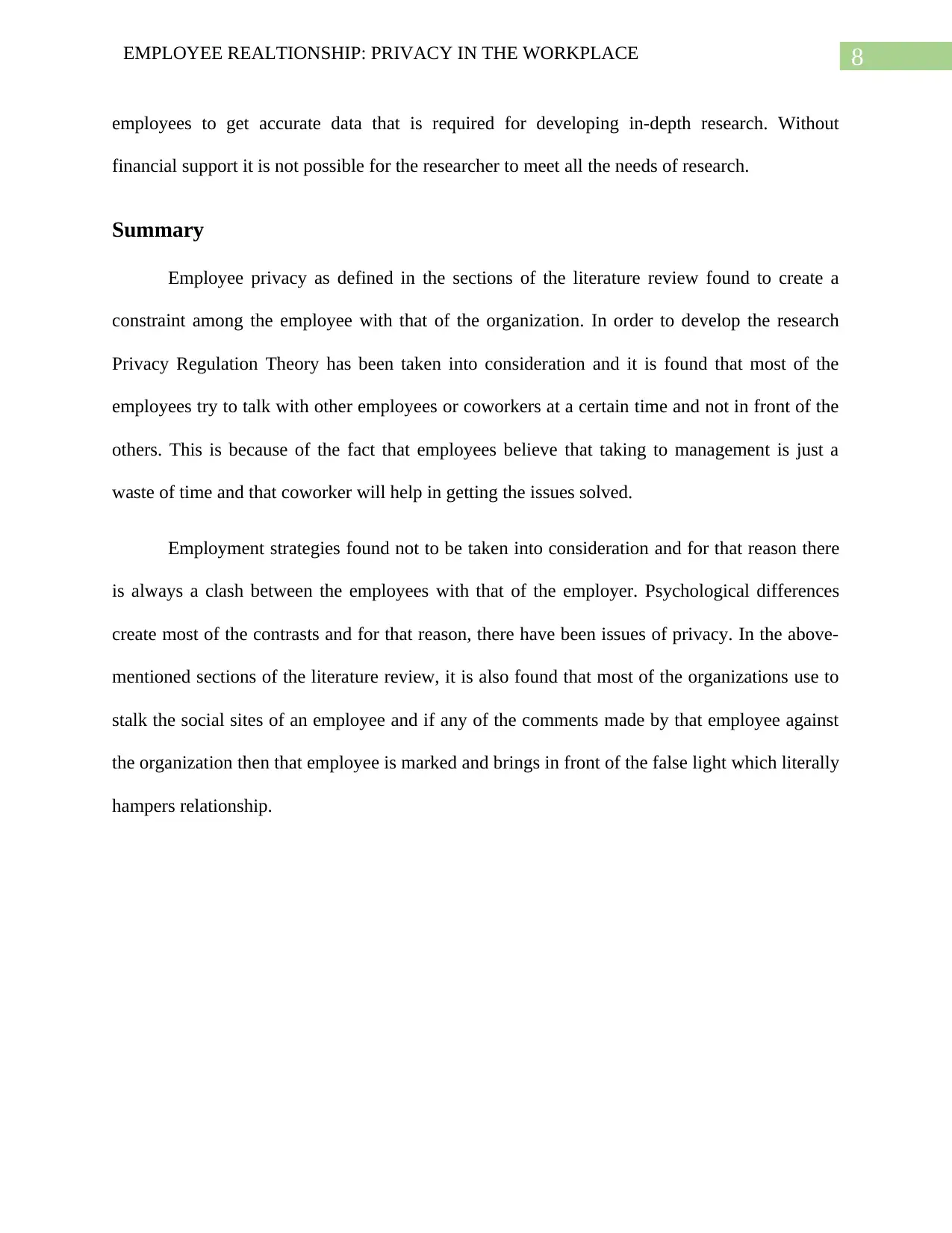
8EMPLOYEE REALTIONSHIP: PRIVACY IN THE WORKPLACE
employees to get accurate data that is required for developing in-depth research. Without
financial support it is not possible for the researcher to meet all the needs of research.
Summary
Employee privacy as defined in the sections of the literature review found to create a
constraint among the employee with that of the organization. In order to develop the research
Privacy Regulation Theory has been taken into consideration and it is found that most of the
employees try to talk with other employees or coworkers at a certain time and not in front of the
others. This is because of the fact that employees believe that taking to management is just a
waste of time and that coworker will help in getting the issues solved.
Employment strategies found not to be taken into consideration and for that reason there
is always a clash between the employees with that of the employer. Psychological differences
create most of the contrasts and for that reason, there have been issues of privacy. In the above-
mentioned sections of the literature review, it is also found that most of the organizations use to
stalk the social sites of an employee and if any of the comments made by that employee against
the organization then that employee is marked and brings in front of the false light which literally
hampers relationship.
employees to get accurate data that is required for developing in-depth research. Without
financial support it is not possible for the researcher to meet all the needs of research.
Summary
Employee privacy as defined in the sections of the literature review found to create a
constraint among the employee with that of the organization. In order to develop the research
Privacy Regulation Theory has been taken into consideration and it is found that most of the
employees try to talk with other employees or coworkers at a certain time and not in front of the
others. This is because of the fact that employees believe that taking to management is just a
waste of time and that coworker will help in getting the issues solved.
Employment strategies found not to be taken into consideration and for that reason there
is always a clash between the employees with that of the employer. Psychological differences
create most of the contrasts and for that reason, there have been issues of privacy. In the above-
mentioned sections of the literature review, it is also found that most of the organizations use to
stalk the social sites of an employee and if any of the comments made by that employee against
the organization then that employee is marked and brings in front of the false light which literally
hampers relationship.
⊘ This is a preview!⊘
Do you want full access?
Subscribe today to unlock all pages.

Trusted by 1+ million students worldwide
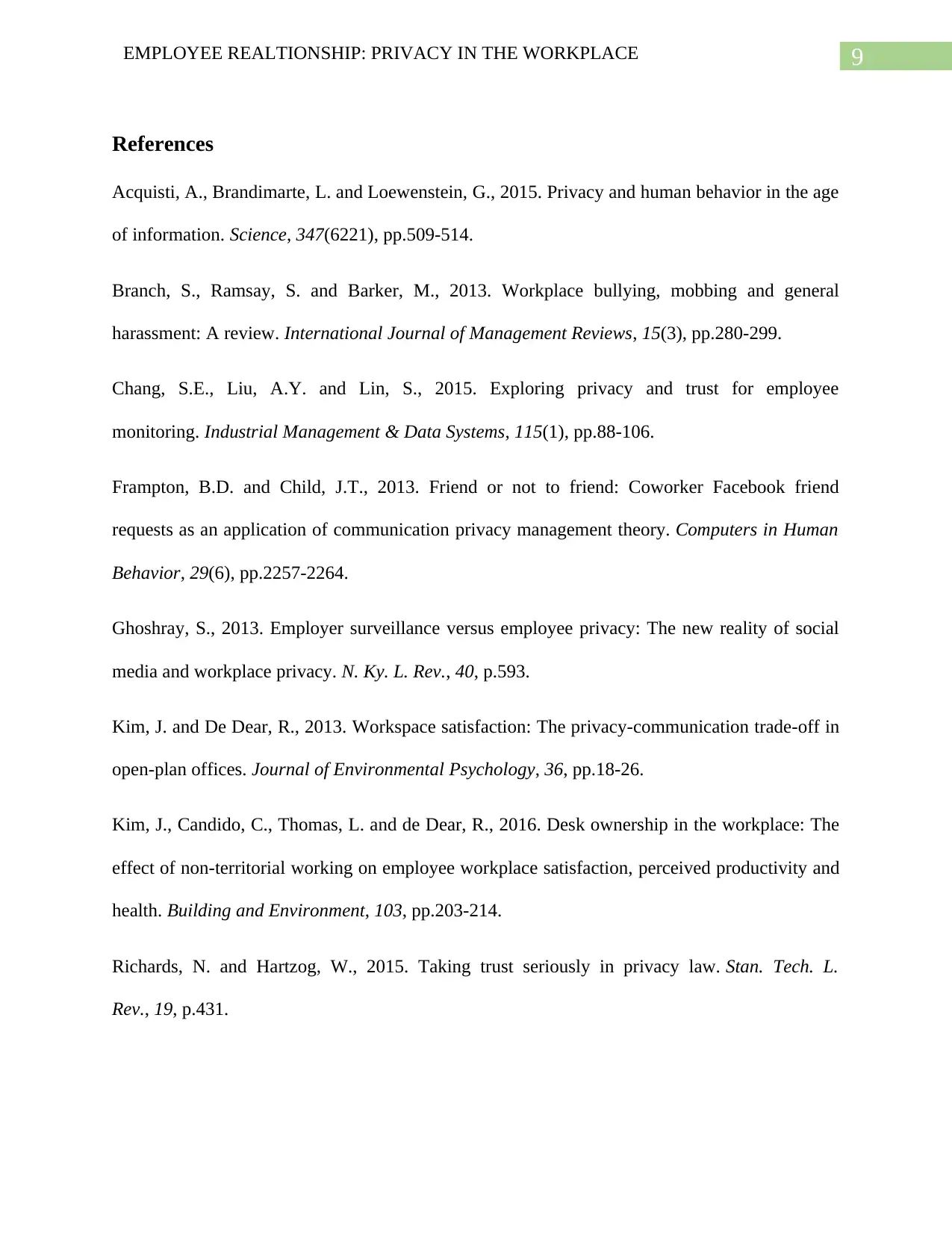
9EMPLOYEE REALTIONSHIP: PRIVACY IN THE WORKPLACE
References
Acquisti, A., Brandimarte, L. and Loewenstein, G., 2015. Privacy and human behavior in the age
of information. Science, 347(6221), pp.509-514.
Branch, S., Ramsay, S. and Barker, M., 2013. Workplace bullying, mobbing and general
harassment: A review. International Journal of Management Reviews, 15(3), pp.280-299.
Chang, S.E., Liu, A.Y. and Lin, S., 2015. Exploring privacy and trust for employee
monitoring. Industrial Management & Data Systems, 115(1), pp.88-106.
Frampton, B.D. and Child, J.T., 2013. Friend or not to friend: Coworker Facebook friend
requests as an application of communication privacy management theory. Computers in Human
Behavior, 29(6), pp.2257-2264.
Ghoshray, S., 2013. Employer surveillance versus employee privacy: The new reality of social
media and workplace privacy. N. Ky. L. Rev., 40, p.593.
Kim, J. and De Dear, R., 2013. Workspace satisfaction: The privacy-communication trade-off in
open-plan offices. Journal of Environmental Psychology, 36, pp.18-26.
Kim, J., Candido, C., Thomas, L. and de Dear, R., 2016. Desk ownership in the workplace: The
effect of non-territorial working on employee workplace satisfaction, perceived productivity and
health. Building and Environment, 103, pp.203-214.
Richards, N. and Hartzog, W., 2015. Taking trust seriously in privacy law. Stan. Tech. L.
Rev., 19, p.431.
References
Acquisti, A., Brandimarte, L. and Loewenstein, G., 2015. Privacy and human behavior in the age
of information. Science, 347(6221), pp.509-514.
Branch, S., Ramsay, S. and Barker, M., 2013. Workplace bullying, mobbing and general
harassment: A review. International Journal of Management Reviews, 15(3), pp.280-299.
Chang, S.E., Liu, A.Y. and Lin, S., 2015. Exploring privacy and trust for employee
monitoring. Industrial Management & Data Systems, 115(1), pp.88-106.
Frampton, B.D. and Child, J.T., 2013. Friend or not to friend: Coworker Facebook friend
requests as an application of communication privacy management theory. Computers in Human
Behavior, 29(6), pp.2257-2264.
Ghoshray, S., 2013. Employer surveillance versus employee privacy: The new reality of social
media and workplace privacy. N. Ky. L. Rev., 40, p.593.
Kim, J. and De Dear, R., 2013. Workspace satisfaction: The privacy-communication trade-off in
open-plan offices. Journal of Environmental Psychology, 36, pp.18-26.
Kim, J., Candido, C., Thomas, L. and de Dear, R., 2016. Desk ownership in the workplace: The
effect of non-territorial working on employee workplace satisfaction, perceived productivity and
health. Building and Environment, 103, pp.203-214.
Richards, N. and Hartzog, W., 2015. Taking trust seriously in privacy law. Stan. Tech. L.
Rev., 19, p.431.
1 out of 10
Related Documents
Your All-in-One AI-Powered Toolkit for Academic Success.
+13062052269
info@desklib.com
Available 24*7 on WhatsApp / Email
![[object Object]](/_next/static/media/star-bottom.7253800d.svg)
Unlock your academic potential
Copyright © 2020–2025 A2Z Services. All Rights Reserved. Developed and managed by ZUCOL.





